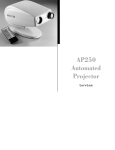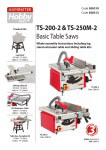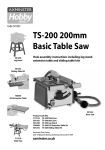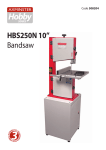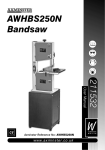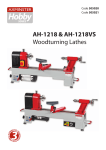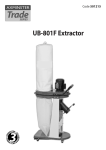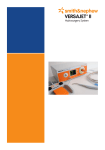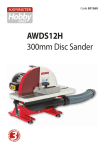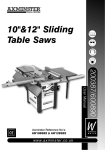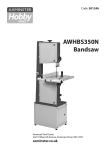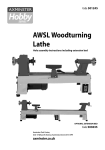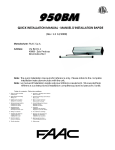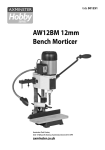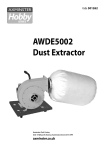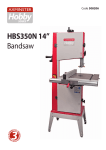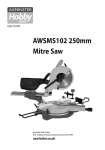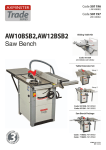Download Axminster 250mm Slide Mitre Saw Operating instructions
Transcript
Code 508211 AXMINSTER Hobby SERIES 508213 Leg Stand TS-250M 250mm Basic Table Saw Hole assembly instructions including leg stand extension table and sliding table kits 508214 Sliding Table Kit 508212 R/H Extension Table 508211 Basic Saw 717540 Table Saw and Accessories Product Kit Codes 717540: 508211: 508213: 508212: 508214: TS-250M Table Saw and Accessories TS-250M Basic Saw TS-250M Leg Stand TS-250M R/H Extension Table Kit TS-250M Sliding Table Kit Index of Contents Index of Contents 02 Declaration of Conformity 02 What’s Included 03-04 Optional Accessories 05-06 General Instructions for 230V Machines 07-08 Specific Instructions/Precaution for the Saw Table 08 Specification09 Assembly09-10-11-12-13-14-15-16-17-18 Illustration and Parts Description 19-20-21 Setup and Adjustments 22-23-24 Operating Instructions 25-26 Changing the Saw Blade 26-27 Parts Breakdow/List 28-29-30-31 Wiring Diagram 31 Declaration of Conformity Copied from CE Certificate Manufactured by Laizhou Chunlin Machinery Co., Ltd. is in compliance with the standards determined in the following Council Directive. The undersigned, Huibo Wang EN 55014-1:2006+A1+A2 EN 61000-3-2 : 2006+A1+A2 EN 61000-3-3 : 2008 EN 55014-2 : 1997+A1+A2 Authorised by Laizhou Chunlin Machinery Co., Ltd No. 269 Baoshi Road Wenfeng Street Laizhou City, Shandong 261400 P.R. China. Model Number MJ10-SB250 Circular Saw Bench Warning Fully read manual and safety instructions before use Ear protection should be worn The symbols below advise that you follow the correct safety procedures when using this machine. Eye protection should be worn 2 Dust mask should be worn HAZARD Motor gets hot What’s Included Quantity Item Part Model Number MJ10-SB250 (Basic Table Saw Assembly) (Kit Code: 508211) 1 No Basic Table Saw A 1 No Saw Guard with Flexible Hose B 1 No Dust Extraction Moulding with four Phillips Screws C 1 No Mitre Fence Assembly D 1 No (Short) Rip Fence and Clamping Assembly E 1 No (Short) Fence Rail with Scale F 1 No Bag Containing G 2 No Screwdrivers G1 1No Hose Clip G2 2 No 10-12mm Spanners 1 No 13-15mm Spanner G3 1 No 17-19mm Spanner 1 No 3mm and 4mm Hex Keys G4 1 No Push Stick G5 2 No Operating Wheel Handles G6 4 No 4 No 4No 4 No 1 No 32 No 4 No (Optional Stand Assembly) Leg A” Frames H Long Struts I Short Struts J Rubber Feet K Bag Containing L M8x16mm Coach Bolts with Nuts L1 M8x16mm Bolts with Large Washer and Nut L2 (Kit Code: 508213) 1 No 2 No 1 No 6 No 6 No 6 No 3 No 1 No 1 No (Optional R/H Extension Table Assembly) Extension Table M (Long) Front and Rear Fence and Table Extension Rail arms N Bag Containing O M6x25mm Panhead Phillips Screws O1 M6x25mm Panhead Phillips Screws with Square Nuts O2 M6x16mm Panhead Phillips Screws with Square Nuts O3 M6x16mm Bolt Washer and Nut O4 30mm Hose Support Bracket P (Long) Rip Fence Assembly Q (Kit Code: 508212) 1 No 1 No 1 No 1 No 1 No 2 No 1 No 4 No 4 No 4 No 2 No 1 No 1 No (Optional Sliding Table Assembly) Angle Fence R Angle Fence End Block with two Phillips screws R1 Work Clamp Assembly S Flip Over Stop T Work Clamp and Connecting Blocks U Sliding Carriage Support Arms V Bag Containing W M6x35mm Bolt and nut W1 M6x45mm Countersunk Head and Washer/Nut W2 M6x16mm Bolt and Washer/Nut W3 M8x10mm Bolt and Domed Nut (Carriage Arm Stop) W4 Carriage Arm X Sliding Carriage Table Y (Kit Code: 508214) 3 What’s Included Having unpacked your saw and its accessories please dispose of any unwanted packaging properly. The packaging is biodegradable. Basic Table Saw (Code: 508211) A C D E B F G G2 G4 G5 G6 G1 G3 4 Optional Accessories Stand Assembly (Kit code: 508213) K H I L J L1 L2 R/H Extension Table Assembly (Kit code: 508212) O Q M P N O1 O2 O3 5 O4 Optional Accessories Sliding Table Assembly (Kit code: 508214) R Work clamp block S T U W W1 Connecting block V W2 W3 W4 X Y 6 R1 General Instructions for 230V Machines not use any solvents or cleaners, as these may cause damage to any plastic parts or to the electrical components. Keep the work area as uncluttered as is practical, this includes personnel as well as material. Good Working Practices/Safety The following suggestions will enable you to observe good working practices, keep yourself and fellow workers safe and maintain your tools and equipment in good working order. Under no circumstances should CHILDREN be allowed in work areas. WARNING! KEEP TOOLS AND EQUIPMENT OUT OF THE REACH OF YOUNG CHILDREN It is good practice to leave the machine unplugged until work is about to commence, also make sure to unplug the machine when it is not in use or unattended. Always disconnect by pulling on the plug body and not the cable. Once you are ready to commence work, remove all tools used in the setting operations (if any) and place safely out of the way. Re-connect the machine. Primary Precautions These machine are supplied with a moulded 13 Amp. Plug and 3 core power cable. Before using the machine inspect the cable and the plug to make sure that neither are damaged. If any damage is visible have the tool inspected/repaired by a suitably qualified person. If it is necessary to replace the plug, it is preferable to use an ‘unbreakable’ type that will resist damage on site. Only use a 13 Amp plug and make sure the cable clamp is tightened securely. Fuse as required. If extension leads are to be used, carry out the same safety checks on them and ensure that they are correctly rated to safely supply the current that is required for your machine. Carry out a final “tightness” check e.g. guide fence, table tilt, etc., check that the ‘cutting path’ (in this case the path that the work piece will travel) is unobstructed. Make sure you are comfortable before you start work; balanced, not reaching etc. If the work you are carrying out is liable to generate flying grit, dust or chips wear the appropriate safety clothing, goggles, gloves, masks etc. If the work operation appears to be excessively noisy, wear ear-defenders. If you wear your hair in a long style, wearing a cap, safety helmet, hair net, even a sweatband, will minimise the possibility of your hair being caught up in the rotating parts of the tool. Likewise, consideration should be given to the removal of rings and wristwatches, if these are liable to be a ‘snag’ hazard. Consideration should also be given to nonslip footwear, etc. Work Place/Environment Make sure when the machine is placed that it sits firmly on the floor, that it does not rock and is sufficiently clear of adjacent obstacles so that cutting operations will not be impeded. Check you have adequate clearance both in front of and behind the machine when cutting long stuff. If you are liable to be processing unwieldy or awkward work pieces, it is suggested that you consider fastening the machine down to the floor. The machine is not designed for sub-aqua operation, do not use when or where it is liable to get wet. If the machine is set up in the open, and it starts to rain (unusual though this would be in U.K.), cover it up or move it into the dry. If the machine has got wet; dry it off as soon as possible with a cloth or paper towel. Do not use 230V a.c. powered machines anywhere within a site area that is flooded or puddled and do not trail extension cables across wet areas. Keep the machines clean; it will enable you to more easily see any damage that may have occurred. Clean the machine with a damp soapy cloth if needs be, do Do not work with cutting tools of any description if you are tired, your attention is wandering or you are being subjected to distraction. A deep cut, a lost fingertip or worse; is not worth it! Do not use this machine within the designated safety areas of flammable liquid stores or in areas where there may be volatile gases. There are very expensive, very specialised machines for working in these areas, THIS IS NOT ONE OF THEM. 7 General Instructions for 230V Machines Above all, OBSERVE…. make sure you know what is happening around you and USE YOUR COMMON SENSE. Check that blades are the correct type and size, are undamaged and are kept clean and sharp, this will maintain their operating performance and lessen the loading on the machine. Specific Instructions/Precaution for the Saw Table Make sure the saw blade is the correct type for the job in hand. Do not force the saw, if the saw begins to ‘stall’ you are ‘forcing the cut’ or over working the saw. the blade. Leave the machine disconnected from the mains supply until you are about to commence work. Always disconnect the machine if you are leaving it unattended. Ensure that the saw blade is clean and sharp. Never leave the vicinity of the machine unless the blade has come to a complete stop. Resin build up on the blades will increase the friction of the saw passing through the timber, and cause over heating of the blade, blunt teeth will work harder tearing the fibre of the timber as opposed to shearing it, also with subsequent overheating. Both faults unnecessarily load the machine beyond normal usage, and shorten its longevity. Do not attempt to carry out any maintenance, corrective work, setting up etc., unless the machine is disconnected from the mains supply. If any tools have been used during setting up procedures, make sure they are removed from the machine and stowed safely away. Do not use blades that are deformed in any way. Do not attempt to carry out cross cutting operations ‘freehand’, always use the mitre fence for small stuff and the sliding carriage for larger work pieces. Unless you are an experienced machine operator, do not attempt to ‘rip’ freehand, always use the guiding facility of the rip fence. Do not remove the blade guard. The design of the riving knife on the machine will not allow for slotting or ‘blind’ grooving, so there is no reason to remove the guard. Do not remove the riving knife. It is perfectly acceptable to support guide and feed the timber with your hands whilst ripping stuff of some length, however, as you approach the blade ensure that the push stick is to hand, and you use it. Do not use any blades that cut a smaller kerf than the riving knife thickness. Make sure the riving knife is correctly adjusted to the blade and is securely fastened. If the table insert becomes damaged or broken, and will not support the timber ‘up close’ to the blade, replace it. Remember the emphasis of the ‘push’ should be between the blade and the fence and close to the fence. Use your free hand to support and guide the material on the offside of the saw blade and at least 100mm away from it. If the timber does not extend to at least 100mm to the offside of the saw blade, the material possibly? does not need guiding or supporting. Do not start the saw with the work piece touching the blade. Do not commence sawing until the blade has run up to full speed. Check (especially on site), that there are no foreign objects e.g. old nails, screws, small stones etc embedded in the material you are about to cut. If necessary take a wire brush to the timber before working. After switching off, never try to slow the saw down more quickly by applying side pressure (with a piece of wood?) to the blade. Apply the old joiner’s adage of never getting hands within one handbreadth of 8 Specification Code508211 Model TS-250M Basic RatingHobby Power 1.5kW 230V 1ph Blade Dia/Bore 250mm/30mm Blade Tilt 0° to 45° Max Depth of Cut @ 45˚ 60mm Max Depth of Cut @ 90˚ 80mm Max Width of Cut with Fence 160mm standard, 760mm with R/H Table Kit Table Size 635 x 430mm Table Height 360mm Dust Extraction Outlet 100mm Min Extraction Airflow Required 750m³/hr Overall L x W x H 660 x 480 x 400mm Weight80kg Assembly Optional Stand Assembly (Kit Code 508213) Fig 01 Locate and identify the four leg “A” frames (H), the long struts (I) and the short struts (J) for the stand, and the packet containing 32 M8 x 16mm coach bolts, washers and nuts,(L1). I J Using the M8 x 10mm coach bolts, nuts and washers bolt together two ‘A’ frames using two legs (H) one long strut (I) in the middle and one short strut (J) at the top. ‘finger tighten’ the nuts only at this time, see fig 1. L1 H Fig 02 When the two ‘A’ frames have been assembled, select one, turn it upside down on a flat surface and loosely bolt the ‘short struts’ (J) and long struts (I) in place, see fig 2. Attach the other “A’ frame and loosely tighten. When all the components are assembled, turn the stand over and place the four rubber feet (K) to the ends of the ‘A’ frames. (See fig 3) Upright the frame and stand on the floor, see fig 4. J I Fig 04 NOTE: GO ROUND THE FRAME AND FINGER TIGHTEN THE NUTS AT THIS POINT! K Fig 03 9 Assembly Mounting the Saw Bench to the Stand Optional Sliding Carriage Table (Kit Code 508214) 1). With assistance, place the Saw Bench (A) onto the stand. Align the four mounting holes at the base of the Saw Bench with the four mounting holes at each corner of the stand. Using four M8 x 16mm hex bolts, large washers & nuts (L2) secure the Saw Bench to the stand, see figs 05-06-07. 1). Position one carriage support arm (V) to the underside of the cast iron saw bench (A), line up the clearance holes (a) in the support arm with the pre-drilled holes in the table, using four M6 x 45mm countersink heads and nuts, (W2) secure the support arm to the table using a 4mm Hex key (G4), see figs 08-09-10. Repeat for the remaining arm. Fig 05 Fig 08 V a Fig 09-10 W2 V Pre-drilled holes Fig 06-07 L2 2). Place an M6x16mm Hex bolt (W3) in each of the four clearance holes on both support arms (V) and loosely screw on an M6 nut and washer, see fig 11. 2). Now tighten all the nuts on the stand assembly. 3). Locate the four M6x30mm Hex Bolts (W1) and lightly screw each bolt into the threaded holes to the underside of the carriage arm (X), see fig 12. 10 Assembly NOTE: Only screw on the bolts just enough so they are just below the surface of the threaded nut, see fig 11. Make sure the wheels on carriage table engages correctly onto the carriage arm rails, see fig 15. Fig 14-15 4). Line up the Hex bolts (W3) with the ‘T’ slots in the carriage arm (X) and slide on the carriage arm, see fig 13. Fig 11 Y Threaded nuts w3 Fig 12 w1 V Carriage arm rail 6). Slide the carriage table (Y) to one end of the saw table (A), place a Level across both tables and adjust the M6 Hex bolts (W1) until the sliding carriage table (Y) is level with the table saw table (A), see fig 16. Repeat for the opposite side. When both tables are level tighten the four M6 Hex nuts (W3) to secure the sliding arm (X) in position. Fig 13 Fig 16 X ‘T’ Slot w3 5). Locate the sliding carriage table (Y) and slide it onto the carriage arm (X), see fig 14. 11 Continues Over... Assembly 7). Locate the two carriage arm stops (W4), loosen the domed nuts and slide the bolt heads into each end of the carriage arms ‘T’ slot. Tighten the nuts to lock the stop in place, see fig 17. Fig 20-21 ‘T’ Slot Y Fig 17 Connecting block W4 Lift and shift handle Angle Fence 1). Put to hand the work clamp block (U), and slide it into the T-slot on the angle fence (R). Locate the connecting block (U) and slide it onto the angle fence as before, see figs 18-19. Slide the T-bolt on the base of the connecting block (U) into the T-slot on the sliding carriage table (Y), see figs 20-21. Locate the plastic block and Phillips screws (R1), secure it to the end of the angle fence (R), see fig 22. ‘T’ Bolt Fig 22 Fig 18-19 Work clamp block U R1 The picture above shows the angle fence (R) removed from the carriage table for clarity. R 2). Locate the work clamp (S), slot the work clamp into the 20mm hole in the work clamp block (U), secure in position with the lift and shift handle, see fig 23. To set the angle fence at 90˚, push the angle fence (R) up against the stop, see fig 24. ‘T’ Bolt U Connecting block 3). Make sure the plastic block on the end is just missing the blade. Using a 90˚ square check that the blade is at 90˚ to the angle fence (R), see fig 25. When correct tighten the lift and shift handle on the 12 Assembly Fig 23 Fig 26-27 S Grub locking screw U Lift and shift handle Fig 24 Angle fence stop Eccentric bush carriage table (Y), see figs 28-29. Tighten the three lift & shift handles to lock the angle fence in position. Note: The fence can also be used at the rear of the sliding carriage table if you prefer to push the timber against the fence. Fig 25 Fig 28-29 90˚ Square connecting block (U), see fig 21. If the angle fence (R) is not set to 90˚, undo the grub screw to the side of the sliding carriage table (Y), using a flat screwdriver turn the eccentric bush until the angle is correct, see figs 26-27. Carriage table scale 4).To set the angle fence (R) to angles between 45˚ and 90˚ loosen the three lift and shift handles on the connecting and work clamp blocks (U) and set the fence to the required angle on the scale on the 13 Continues Over... Assembly 5). Locate the flip over stop (T) and slide it into the T-slot on top of the angle fence (R), see fig 30. Tighten the butterfly knob. Fig 32-33 Height mechanism shaft Fig 30 G6 a T Tilt mechanism shaft R Mitre Fence Locate the Mite fence assembly (D) and slide it into one of the saw tables “T” slots, see fig 31. Fig 31 Saw Guard D Find the saw guard (B), remove the flexible hose, remove the lift and shift handle and threaded pin from the guard and place safely aside. Slot the saw guard over the riving knife and line up the pre-drilled holes, replace the threaded pin and handle then lightly tighten (DO NOT OVERTIGHTEN), see fig 34. Fig 34 Operating Wheel Handles Locate the two operating wheel handles (G6) and, using the supplied 3mm Hex key (G4), secure one to the height mechanism shaft to the front of the saw by undoing the grub screw on the operating wheel handle (G6) and sliding it onto the shaft, making sure the grub screw is in line with machined slot (a), in the shaft. Retighten the grub screw. Repeat for the tilt mechanism to the right hand side of the saw, see figs 32-33. Threaded pin Lift and shift handle 14 Assembly Fig 37-38 Optional Extension Table (Kit Code 508212) NOTE: KIT CODE 508211 COMES WITH THE FENCE SUPPORTING ARM ONLY AND DOES NOT INCLUDE THE REAR SUPPORTING ARM! N 1). Put to hand six M6 x 25mm Phillip head screws with square nuts (O2), remove the nuts and place the screws into the three holes to the front and rear of the main saw table (A). Replace the nuts. (Note: Leave a gap between the base of the table and nut), see figs 35-36. Plastic cover Fig 35-36 A ‘T’ Slot Fig 39-40 O2 N 2). Locate the two extension rail support arms (N). Remove the plastic cover to the left hand side of the support arm with the scale, see fig 37. Line up the ‘T” slot to the end of the rail arm and slot it over the M6 nuts, see fig 38. Push the extension rail so it is flush with the end of saw table (A) and lightly secure the extension support arm using a Phillips screwdriver, see fig 39. Replace the plastic cover you removed earlier, see fig 40. Repeat for the other extension support arm. Plastic cover 15 Continues Over... Assembly 3). Put to hand six M6 x 16mm Phillip head screws with square nuts (O3), remove the nuts and place safely aside. Slot the screws into each of the 6 holes on the extention table lip (M), replace the square nuts, see figs 41-42. (Note: Leave a gap between the base of the extension table lip and nut) Fig 44 Fig 41-42 03 O3 ‘T’ Slot Fig 45 M M M6x16mm Phillips screw Fig 46 4). Remove the plastic covers from the ends of the two extension table support arms (N), see fig 43. Offer up the M6 nuts to the support arms T-slots and slide on the extension table (M) into the support arms (N). Push the extension table (M) until it is flush up against the saw table (A), place six Phillips screws (O1) into the captive nut locations, place a level between both tables, adjust the screws (O1) until both tables are level. Tighten the six M6 Phillips screws (O3) to clamp the extension table to the supporting arms (N). Replace the plastic covers you removed earlier, see figs 44-45-46-47. Fig 43 O1 Captive nut Fig 47 Plastic cover O1 16 Assembly Rip Fence Fig 50-51 NOTE: THIS ASSEMBLY OLNY APPLIES IF YOU HAVE PURCHASED KIT CODE: 508212 Q 1). Remove the fence clamp assembly from the rip fence (E) by lossening the clamping bolt to the base of the asssebly. using a 10mm socket/spanner. Locate the rip fence (Q), slot the steel square clamp into the T-slot to the end of the rip fence and tighten the bolt, see figs 48-49. Clamp asssembly Fig 48-49 Clamping bolt Steel square clamp Dust Extraction 10mm socket/spanner Q 1). Locate 30mm hoses (B), hose clips (G2), 100mm dust extraction moulding with four Phillips screws and washers (C). 2). Place one of the hose clips over one end of the 30mm hose and fit the hose over the table saws dust extraction outlet and nip tight, see fig 52. Fig 52 B 2). Lower the fence assemby so the clamp assembly slots over the fence extention table support arm (N). Clamp the fence assembly in position by turning the lift and shift handle clockwise, see figs 50-51. G2 Note: Lubricate the Fence supporting arm (N) and the underside of the clamp assembly so the rip fence assembly runs smoothly back and forth. DO NOT OVERTIGHTEN as the guard is only plastic! 17 Continues Over... Assembly 3). Line up the holes in the extraction moulding (C), with the threaded holes to the rear of the saw table (A) and secure in place with the Phillips screw and washers, see fig 53. Fig 55 P 4). Slide the remaining hose clip over one end of the 30mm hose and fit the hose over the table saws 30mm dust extraction moulding outlet and nip tight, see fig 53. ‘T’ slot Fig 53 O4 C B G2 Fig 56-57 Phillips screws Ring Code 508212 Only 5). Locate 30mm hose support bracket (P) and two M6x16 Hex bolts, washers and nuts (O4). Remove the plastic cover from the end of the rear extension table support arm (N) and place safely aside. Remove the nuts and washers from the Hex bolts, introduce the bolts through the pre-drilled holes in the support bracket plate (P) and replace the washers and nuts, see fig 54. NOTE: Leave a gap between the Hex bolt head and support bracket plate for the next step. Fig 54 Cover 6). Turn the bracket support (P) so the ring is facing upwards, line up the two Hex bolts (O4) with the ‘T’ slot and slide the support bracket assembly on. Leave sufficant space to replace the plastic cover. Tighten the Hex nuts to sercure the assembly, see figs 55-56. Replace the cover to the end of the support arm, see fig 57. 7). Slot the flexible hose (B) through support ring (P), see fig 58 and secure it to the extraction moulding (C) as described in step 3. Fig 58 Support bracket plate P O4 B 18 P Illustration and Parts Description B S T Q P U M A N J H W4 E G6 L1 I F K TS-250M Table Saw Kit Code 717540 Basic Table Saw Kit Code 508211 Part Description Part Description A Basic Table Saw M Extension Table B Saw Guard with Flexible Hose N Long Fence and Table Extension Rail Arms C 50-100mm Dust Extraction Moulding (see page 20) P 30mm Hose Support Bracket D Mitre Fence (see page 20) Q Long Rip Fence Assembly E Short Rip Fence and Clamping Assembly (not shown) R Angle Fence (see page 20) F Short Fence Rail with Scale (not shown) S Work Clamp Assembly G6 Operation Wheel Handles T Flip Over Stop H Leg ‘A’ Frames U Work Clamp and Connecting Blocks I Long Struts V Sliding Carriage Support Arms (see page 20) J Short Struts W4 K Rubber Feet X Carriage Arm L1 M8x16mm Coach Bolt Y Sliding Carriage Table 19 Carriage Arm Stop Continues Over... Illustration and Parts Description D R Y B M V N X C A Clamp B Work clamp block (A) and connecting block (B) Flip over stop assembly 20 Illustration and Parts Description Clamping knob Shroud OFF ON Scale Pointer Mitre fence assembly NVR ON/OFF switch with emergency stop shroud Adjusting screw Pointer Scale Tilt operating handle Tilt scale pointer and adjusting screw Tilt mechanisum clamp Scale Rise and fall operating handle and the clamping handle for the tilt mechanisum Carriage table scale for measuring set angles 21 Setup and Adjustments The Riving Knife Adjusting the Rip Fence to the Blade 1). Raise the saw blade to its highest point and remove the saw blade guard, see fig 34 on page 14. The fence assembly must be parallel to the saw blade for producing accurate cuts. 2). Remove the four Hex screws and place carefully aside, remove the table insert, see fig 59. Using the spanner provided loosen the riving knife and adjust until the tip of the riving knife is no more than 8mm away from the saw blade and re-tighten, see fig 60. 1). Loosen the fence clamping handle and slide the fence assembly up against the saw blade and check it reads “ZERO” on the fence rail (F) or on the table extension support arm (N), see fig 62. NOTE: Check that the riving knife is parallel to the saw blade by placing the fence up against them. (See fig 61). NOTE: If the fence assembly does not line up correctly with the “ZERO” marker on the scale you will need to adjust the fence rails (F-N) until correct. Fig 59 Fig 62 Table insert ZERO marker Riving knife 8m m 8m m Fig 60-61 NOTE: Use the ‘T’ slot to the right side of the saw blade as a reference to check the fence is parallel, see figs 63-64. Regularly check the fence is parallel to ensure a perfect cut. Fig 63-64 R Tables ‘T’ slot 22 Setup and Adjustments 4). The rip fence (E-Q) can be repositioned to face the opposite direction for guiding thin timber pieces through. Adjusting the Pivot Release the locking handle (A), see fig 67-68 the saw can be angled up to a maximum of 45˚ by turning the hand wheel (G6), see figs 68-69. 5). Loosen the square clamp bolt beneath the clamp assembly (E-Q), see figs 48-49 on page 17, turn the fence around so the large surface of the fence is pointing away from the blade, re-attach the fence clamp assembly. The two illustrations below, figs 6566, shows the fence in both positions. Fig 68 Fig 65-66 A E Q G6 The small surface of the fence is for guiding thin timber through. Fig 69 The small surface of the fence is for guiding thick timber through. G6 Adjusting the Cutting Height Adjust the blade height with the hand wheel (G6), see fig 67, so that the blade teeth are protruding through the work piece. Fig 67 Lock G6 23 Continues Over... Setup and Adjustments Setting the Blade Alignment If the blade is not cutting 100% true, the blade is out of alignment. Follow the instructions below on how to set the blade to the table. 1). Remove the blade guard and table insert, see fig 70. 2). Loosen the four Hex screws (A), see figs 70-71. 3). Place a steel rule up-against one end of the blade and take a measurement to the ‘T’ slots edge, see fig 72. 4). Place the rule to the opposite end of the blade and take a further reading, see fig 73. 6). If there is any deviations between the measurements,adjust the blade assembly by moving each end on it’s rails (B) (beneath the table), see figs 74-75, until both ends of the blade are the same distance away from the ‘T’ slot edge. 7). Tighten the four Hex scews (A). 8). Replace the blade guard and table insert. Fig 73 Fig 70-71 A A Table insert Fig 74-75 Blade rail Blade assembly A Fig 72 B Steel rule Table ‘T’ slot 24 Operating Instructions Fig 76 NOTE: BEFORE USING YOUR SAW, GO ROUNDAND MAKE SURE EVERYTHING IS SECURE, FASTENED DOWN, THAT ALL TOOLS ARE CLEARED AWAY FROM THE WORK AREA! CHECK: THE BLADE FOR SHARPNESS,MISSINGTEETH, RESINBUILDUP ECT., CLEAN IF NECESSARY. CHECK THE BLADE IS SECURELY CLAMPED IN PLACE (I.E. NOT LOOSE)! Fig 77 CONNECT THE SAW TO THE MAINS SUPPLY! Give the machine a ‘quick’ burst check ( i.e. quick ON-OFF) to ensure everything is O.K. If everything is satisfactory, the table saw is ready for use. WARNING! KEEP TOOLS AND EQUIPMENT OUT OF THE REACH OF YOUNG CHILDREN! UNDER NO CIRCUMSTANCES SHOULD CHILDREN BE ALLOWED IN THE WORK AREAS! Feeding the Work by Hand CONNECT A DUST EXTRACTON MACHINE TO THE DUST EXTRACTION OUTLET ON YOUR TABLE SAW! NOTE: Secure larger pieces of timber to the table by using the clamp assembly (S), see page 23. Cutting Narrow Pieces Use the small flat surface of the fence (E-Q) to cut thin timber narrower that 120mm, see fig 65. Use a push stick. The Mitre Fence The mitre fence (D) can be mounted on either side of the saw blade in the two ‘T’ slots, pre machined into the saw table, see fig 78. The mitre fence can be angled from 90˚ to 45˚ degrees, see fig 79-80. Fig 78 ‘T’ Slot Start up the saw, wait until it has reached full speed and slowly feed the timber through using both handles, (making sure to keep your hands well clear of the blade and using a push stick for small pieces), until the timber is behind the riving knife. Switch off the saw, wait until the blade has come to a complete stop and remove the timber, see figs 76-77. D 25 Continues Over... Operating Instructions Fig 79 Fig 80 THE BLADE IS SET AT AN ANGLE LESS THAN 90˚ DEGREES FOR BEVEL CUTS HOLD THE WORK FIRMLY LOCK THE MITRE FENCE AND HOLD THE WORK FIRMLY BLADE GUARD Changing the Saw Blade 1). Raise the saw blade to its highest point, remove the saw blade guard, remove the four Hex screws that secure the table insert, place carefully aside and remove the table insert, see fig 81. Using the spanner provided, put the spanner onto the flats on the bolt and place a peace of timber up against the saw blade to stop it from moving, see fig 82. Fig 82 Saw bolt Spanner NOTE: BE CAREFUL NOT TO DISTURB THE SHIMS BENEATH THE TABLE INSERT IF FITTED AS THE SHIMS ARE SET SO THE TABLE INSERT IS LEVEL WITH THE TABLE SURFACE! 2). Slacken off the saw bolt (remember right hand thread). Remove the saw nut, then remove the sawplate washer and the saw blade, see figs 83-84. It would be a good time to give the interior of the machine, the dust extraction channels, etc. a thorough clean. Fig 81 Hex screw Table insert height shims 3). Check the new blade for damage, missing teeth, sharpness etc. Fit the new blade, ensure that the teeth are pointing towards the front of the machine. Put the sawplate washer onto the shaft and twist on the saw bolt. Spin the bolt up finger tight and check the saw is correctly seated. 4). Place the piece of timber against the blade as before and tighten up the saw bolt, check the riving knife is aligned with the saw blade, and correctly positioned. Replace the table insert and secure with the four Hex screws. Replace the saw blade guard. When everything is satisfactory, turn the saw blade once by hand to check it doesn’t foul anywhere. 5). Reconnect the machine to the mains supply. Give the machine a ‘quick’ burst check (i.e. quick ON-OFF) to ensure everything is O.K. If everything is satisfactory, continue to use the machine. 26 Changing the Saw Blade 6). Check the old blade for sharpness, missing teeth, resin build up, etc., clean if necessary and send for refurbishment/resharpening if required. If the blade is not to be re-sharpened, clean and pack away in its storage case. Fig 83 Fig 84 Sawplate washer Sawplate washer Maintenance 1). Keep the saw as clean and free from saw dust build up as is practical. Periodically, remove the saw gullet and vacuum out and clean out the saw box and the extraction housing. Remove any resin build up in the saw box, using a proprietary resin cleaner. 2). Clean the threaded drive shafts of the rise and fall and tilt mechanisms. At the same time check the belt drive, i.e. the belt is not ‘glazing’ with resin build up, likewise with the pulley wheels. Check the belt tension. If the belt is becoming slack, loosen the motor hold down bolts and drive the motor backward with its adjusting bolt. 3). Check the saw blade regularly for chipped, missing, damaged teeth etc. and remove any resin build up from the blade, riving knife etc. 4). If you have finished using the saw bench, clean above and below the work table and using a damp cloth wipe the saw bench over. If the saw bench is not going to be used for a period of time, smear a light coat of oil over the work table and place a dust sheet over the saw bench. 27 Parts Breakdown/List 28 Parts Breakdown/List Part No Q’TY 35 Ball bearing 1 1 Set screw Description 1 36 Ball bearing 1 2 Shaft 1 37 C-Spring 1 3 Hand wheel 1 38 Shaft 1 4 Pin 1 39 Flat head screw M5 1 5 Sharp 1 40 Press block 1 6 Pin 1 41 Supporting plate 1 7 Screw 1 42 Washer 2 8 Motor 1 43 Nut 2 9 C-Spring 1 44 Washer 1 10 Motor guidance plate 1 45 nut 2 11 Arbor 1 46 Washer 6 1 12 Washer 3 47 T-nut M6 2 13 Set screw 3 48 Sawing base 1 14 Set screw 2 49 Pin 1 15 Washer 1 50 Set screw 1 16 Long plate 1 51 washer 6 1 17 Washer 1 52 Connecting plate 1 18 Nut 2 53 Lock bolt M5 1 19 Motor pulley 1 54 Screw 1 20 Extractor connecting piece 1 55 Screw 1 21 Washer 1 56 Hand wheel 1 22 Set screw 1 57 Screw M20 2 23 Riving Knife (Splitting wedge) 1 58 Nut M20 1 24 Flange 1 59 Threaded shaft 1 25 Washer 1 60 Plate 1 26 Set screw 1 61 Clamp 2 27 Washer 2 62 Dust extraction pipe 1 28 Set screw 2 63 Base 1 29 Holding plate A 1 64 Switch Box 1 30 Riving Knife (Splitting wedge) 1 65 Switch 1 31 Holding plate B 1 66 Clamp for cord 1 32 Poly-V belt HR410 1 67 Set screw 4 33 Spindle pulley 1 68 Power Cord 1 34 Washer 5 2 69 Washer 1 29 Parts Breakdown/List 30 Parts Breakdown/List 70 Arbor 1 86 Scale 1 71 Plate 2 87 Guide 2 72 Supporting rear 2 88 Bolt 1 73 Washer 2 89 Tap screw 4 x12 1 74 Nut M20 1 90 Flat head screw M4 x 8 6 75 Table 1 91 Right protection plate 1 76 Cover 1 92 Flat head screw M4 x 8 1 77 Screw 6 93 Safety screen (right) 1 78 Screw 4 94 Left protection plate 1 79 Pin 1 95 Tap screw 4 x 24 2 80 Scale 1 96 Lock bolt 1 81 Lock handle 1 97 Washer 5 1 82 Stop ruler 1 98 Screw M5 x 12 4 83 Plate 1 99 Washer5 4 84 Guide 1 100 Dust cover 1 85 Lock handle 1 Wiring Diagram 31 The Axminster guarantee is available on Hobby, Trade, Industrial, Engineer, Air Tool & Axcnc Technology Series machines It’s probably the most comprehensive FREE guarantee ever- buy with confidence from Axminster! So sure are we of the quality, we cover all parts and labour free of charge for three years! • Look for the icon and put your trust in Axminster • No registration necessary - just keep your proof of purchase • Optional Service Plan for Industrial Series machinery Great value & easy-to-use, perfect for use at home Solid, reliable machines designed for daily use Top performers with class leading features and build quality for use in busy workshops Quality, precision machines for the workshop or education Small machines for the home engineer Compressors and tools for home or workshop use; durable and great value Free Three Year Guarantee on Axminster Hobby, Trade and Industrial Series woodworking and engineering machines, Axminster Air compressors and Air Tools, and bench top grinders - no registration necessary just proof of purchase. We will repair or replace at our discretion and will collect only from a UK mainland address, irrespective of the original delivery address. The Guarantee assumes that you have bought the correct machine for the required operation, in accordance with our guidelines; have operated and maintained it in accordance with the instruction manual; and that all cutting machines will be used with a blade which is sharp and serviceable at all times. It does not cover consumable items purchased with the original product, including original blades or abrasives. Precision CNC machines for industry and education Normal wear and tear; misuse, abuse and neglect are excluded and the machine should not have been modified in any way. Please do not attempt to service the product without first contacting us; we are happy to guide you but failure to do so may invalidate the guarantee. The Guarantee is transferable from owner to owner in the first three years but you must have original proof of purchase. Should we need to replace a machine in the first three years the guarantee will still continue to be effective from the original purchase date. Full Terms and Conditions can be found at axminster.co.uk/terms This guarantee does not affect your statutory rights. For more information visit axminster.co.uk/3years Please dispose of packaging for the product in a responsible manner. It is suitable for recycling. Help to protect the environment, take the packaging to the local recycling centre and place into the appropriate recycling bin. Only for EU countries Do not dispose of electric tools together with household waste material. In observance of European Directive 2002/96/EC on waste electrical and electronic equipment and its implementation in accordance with national law, electric tools that have reached the end of their life must be collected separately and returned to an environmentally compatible recycling facility. Axminster Tools & Machinery Ltd Weycroft Avenue, Axminster, Devon EX13 5PH axminster.co.uk
































